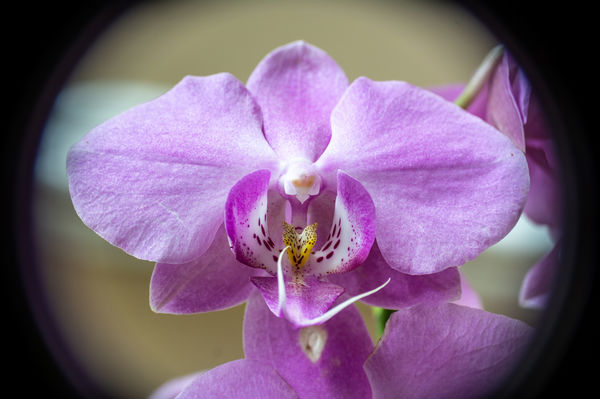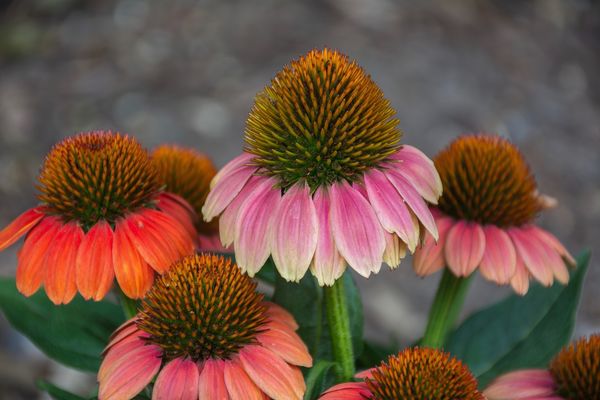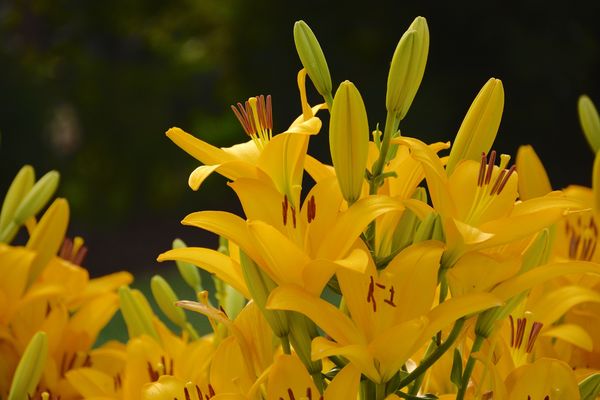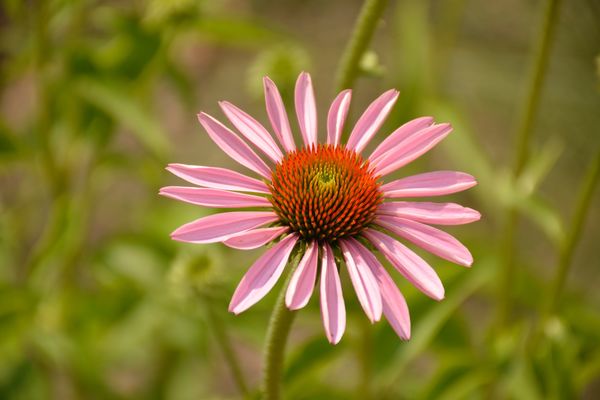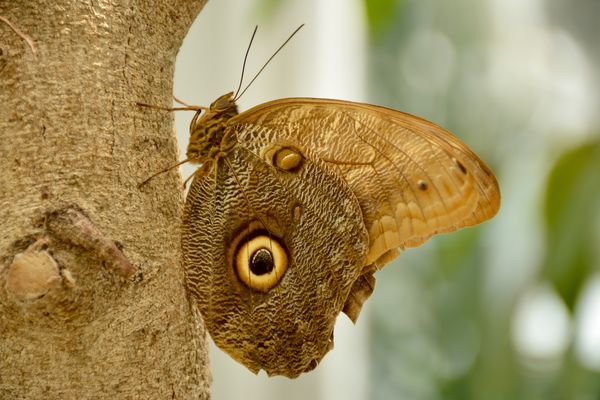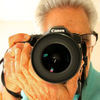Raynox dcr 150 vignette
Jul 17, 2021 23:34:48 #
This was a test using my Nikon 18-140mm combined with a Raynox dcr 150. It’s a (5) image shot focus stack using Elements+ an Elements 2021 Plug-in that opens up Photoshop features hidden in the software. I used a tripod, no flash, f/8, iso 100, shot at 35-50mm, 1.16 seconds. I called Raynox and they say their diopter is made for wide angle lenses, while others claim it works best on telephoto lenses. Either way I get a hard vignette. I tried it on my grandson’s Canon Powershot SX10 bridge camera and it went away (vignette) but only when fully extended 400mm. No images to share.
What am I missing?
We are building a macro presentation for our Williamsburg Photography Meetup. We want to show the different methods.......1:1 macro lens, extension tubes with 50MM prime lens and diopters.
Thanks so much!
I'm a newbie to Macro, kicking tires with tests & tries.
What am I missing?
We are building a macro presentation for our Williamsburg Photography Meetup. We want to show the different methods.......1:1 macro lens, extension tubes with 50MM prime lens and diopters.
Thanks so much!
I'm a newbie to Macro, kicking tires with tests & tries.
Jul 18, 2021 06:55:20 #
I complement ABJanes, UHH needs more studies like his. We live in a very technical world once we step out of simplistic point-and-shoot cameras. [I am not talking about compact sophisticated Superzoom 1" sensor cameras, they are not simplistic and should not be called point-and-shoot.]
Elements+ is a $12 addon to PSE, ABJanes said, "Elements+ an Elements 2021 Plug-in that opens up Photoshop features hidden in the software."
https://elementsplus.net/
The Raynox dcr-150 is about $70 on Amazon. This snap-on adds 1.5x for macro work. This lens has 3 elements.
Note that the OPTEKA has 4 elements compared to Raynox 3. Elements are combined glass with differing refractive indexes which combined reduce chromatic aberration (CA).
The OPTEKA 10x is bout $20 for 55mm and $35 for 77mm on B&H, "this add-on lens features a four-element construction made from high refractive index, low dispersion clear optical glass for maintained image quality. A hard anti-reflective coating has also been applied to the glass elements to reduce lens flare and ghosting for greater contrast and clarity."
https://opteka.com/search?type=product&q=10x*
When I bought my close-up attachment I chose Opteka because it was a screw-on and had more elements.
Opteka close up attachments come in a set of lower power:
https://opteka.com/products/opt-optcu67a?_pos=3&_sid=03c046499&_ss=r
Elements+ is a $12 addon to PSE, ABJanes said, "Elements+ an Elements 2021 Plug-in that opens up Photoshop features hidden in the software."
https://elementsplus.net/
The Raynox dcr-150 is about $70 on Amazon. This snap-on adds 1.5x for macro work. This lens has 3 elements.
Note that the OPTEKA has 4 elements compared to Raynox 3. Elements are combined glass with differing refractive indexes which combined reduce chromatic aberration (CA).
The OPTEKA 10x is bout $20 for 55mm and $35 for 77mm on B&H, "this add-on lens features a four-element construction made from high refractive index, low dispersion clear optical glass for maintained image quality. A hard anti-reflective coating has also been applied to the glass elements to reduce lens flare and ghosting for greater contrast and clarity."
https://opteka.com/search?type=product&q=10x*
When I bought my close-up attachment I chose Opteka because it was a screw-on and had more elements.
Opteka close up attachments come in a set of lower power:
https://opteka.com/products/opt-optcu67a?_pos=3&_sid=03c046499&_ss=r
Jul 18, 2021 08:50:44 #
dpullum wrote:
I complement ABJanes, UHH needs more studies like ... (show quote)
Thanks for your response. My concern is the hard vignette. What causes it and is there something technically I am not doing properly or do you just have to crop it out? I call my approach "the poor man's beginners try at macro". We will discuss used equipment as well to help make the macro genre more palatable.
Jul 18, 2021 09:50:52 #
fetzler
Loc: North West PA
Raynox lenses are rather good and I use them with my macro lens to reach magnifications greater than 1:1. I have several Raynox lenses that have different powers. The lenses have different focal length requirements in order to prevent vignetting. Raynox lenses are rather good but not particularly cheap. The weakest Raynox lens that I have is the DCR 250.
I have not noticed vignetting with my m.zuiko 60mm macro lens or my 85mm micro-nikkor. I suspect you must select a longer focal length. There is information in the Raynox documentation. According to Raynox ,
http://www.raynox.co.jp/english/digital/d_slr/index.html
you need to use a lens of 75mm (35mm equivalent) or greater to prevent vignetting. The DCR 150 is a +4.8 diopter lens.
Using a step down ring instead of the adapter leads to more secure fitting to the lens. Are you sure that you have correctly mounted the adapter?
The flower that you have photographed is rather large. Are you sure you need a macro lens for this subject? I have several non-macro lenses that could photograph this subject with out issue.
I have not noticed vignetting with my m.zuiko 60mm macro lens or my 85mm micro-nikkor. I suspect you must select a longer focal length. There is information in the Raynox documentation. According to Raynox ,
http://www.raynox.co.jp/english/digital/d_slr/index.html
you need to use a lens of 75mm (35mm equivalent) or greater to prevent vignetting. The DCR 150 is a +4.8 diopter lens.
Using a step down ring instead of the adapter leads to more secure fitting to the lens. Are you sure that you have correctly mounted the adapter?
The flower that you have photographed is rather large. Are you sure you need a macro lens for this subject? I have several non-macro lenses that could photograph this subject with out issue.
Jul 18, 2021 10:27:58 #
dpullum wrote:
I complement ABJanes, UHH needs more studies like ... (show quote)
I would plan to use the Opteka 67MM set on my 18-140MM Nikon Lens. Do you think I will be pleased with the combination? I see mixed reviews on the web. I would use my my Nikon SB700 on-camera flash with an Angler Diffuser. I have also been using my 36MM extension tubes with my 50MM f/1.8 with the same flash setup. Thanks for your input.
Jul 18, 2021 10:35:36 #
fetzler wrote:
Raynox lenses are rather good and I use them with ... (show quote)
I feel pretty certain I tried 75MM or great = 1.5 x C-crop 115MM. I would agree on the size of the flower I was just testing the diopter and my first attempts at focus stacking. What are your thoughts on the Opteka diopter set being used on my Nikon 18-140MM F mount? Thanks again for pitching in. I would just purchase the Sigma 105MM f/2.8 considered "best in class" with a 12" working distance but "will I use it enough or will it sit in my bag?'
Jul 18, 2021 11:18:37 #
I don't know how to predict which focal length will give vignetting or not with this Raynox lens. For me, it would be mainly a matter of just trying it. Cropping would be the solution for the current arrangement, and personally I think it is a viable option. It wouldn't bother me at all to crop this picture and call it a success.
A Raynox 250 will be more powerful, showing only the center of the image you see here so it will show very little if any vignetting.
As for the presentation, the likely things to bring up for lenses are:
> Reversing rings (the cheapest option. But need to pre-set the aperture).
> Extension tubes (cheap and versatile. A bit tedious in the switching in and out department).
> Good diopters (also pretty cheap, and the most convenient for the general photographer who wants to quickly move from landscapes --> close up--> landscape).
> Macro lenses (now we are gettin' serious! But the lenses are good for other things too).
But also very important is lighting and diffusion. I'm sure you know that one needs smaller apertures for macro if you want some depth of focus, but smaller apertures mean you often need a flash. The built in flash is often not powerful enough, and a longer lens rig won't work well with it since the lens casts a shadow over the subject. So an external flash is important. And the light needs to be diffused & deflected downward. A diffuser can be simple (a "cup" made of Kleenex paper, or a chunk of translucent white milk jug plastic), commercial, or a more involved but home-made diffuser. There are tons of pictures online showing different diffusers.
A Raynox 250 will be more powerful, showing only the center of the image you see here so it will show very little if any vignetting.
As for the presentation, the likely things to bring up for lenses are:
> Reversing rings (the cheapest option. But need to pre-set the aperture).
> Extension tubes (cheap and versatile. A bit tedious in the switching in and out department).
> Good diopters (also pretty cheap, and the most convenient for the general photographer who wants to quickly move from landscapes --> close up--> landscape).
> Macro lenses (now we are gettin' serious! But the lenses are good for other things too).
But also very important is lighting and diffusion. I'm sure you know that one needs smaller apertures for macro if you want some depth of focus, but smaller apertures mean you often need a flash. The built in flash is often not powerful enough, and a longer lens rig won't work well with it since the lens casts a shadow over the subject. So an external flash is important. And the light needs to be diffused & deflected downward. A diffuser can be simple (a "cup" made of Kleenex paper, or a chunk of translucent white milk jug plastic), commercial, or a more involved but home-made diffuser. There are tons of pictures online showing different diffusers.
Jul 18, 2021 12:31:16 #
I use the Raynox DCR-150 as a 'tube lens' for infinity microscope objectives for it has an equivalent focal length of 208mm.
I've used it as a 'magnifier' on other camera lenses and I have had success with it on primes and not-so-good results on my zoom lenses and with lenses of larger diameter glass the spring-tension mounting blocks much of the lens so I have little use for it with larger diameter lenses and if I were to use screw-on adapters the result would be the same.
If I were to take highly detailed images of flowers my first choice of lens would not be one with a magnifier attached. Deciding factors for me would be the size of the flower, how close I could get to it?, do I want to showcase the entire bloom?, do I want to showcase the reproductive parts showing the pollen? what lighting will I be using?
An often overlooked lens that produces stellar flower images is a wide angle lens which allows for a very close focus distance. Although not a macro in the true sense of the term, they do produce high level of details being that close to the subject. My favorite is a 17-30mm on a full-frame camera and add a short 12mm extension tube and it opens up an entire new world of viewing.
I've used it as a 'magnifier' on other camera lenses and I have had success with it on primes and not-so-good results on my zoom lenses and with lenses of larger diameter glass the spring-tension mounting blocks much of the lens so I have little use for it with larger diameter lenses and if I were to use screw-on adapters the result would be the same.
If I were to take highly detailed images of flowers my first choice of lens would not be one with a magnifier attached. Deciding factors for me would be the size of the flower, how close I could get to it?, do I want to showcase the entire bloom?, do I want to showcase the reproductive parts showing the pollen? what lighting will I be using?
An often overlooked lens that produces stellar flower images is a wide angle lens which allows for a very close focus distance. Although not a macro in the true sense of the term, they do produce high level of details being that close to the subject. My favorite is a 17-30mm on a full-frame camera and add a short 12mm extension tube and it opens up an entire new world of viewing.
Jul 18, 2021 12:38:24 #
Mark Sturtevant wrote:
I don't know how to predict which focal length wil... (show quote)
You're kind as I go full circle on all of this. You mentioned.....& I agree with your statement.... > Good diopters (also pretty cheap, and the most convenient for the general photographer who wants to quickly move from landscapes --> close up--> landscape). What would you consider to be a "good 67MM diopter set" for my 18-140MM Nikon Lens? Opteka for Nikon? I have been testing & trying for weeks. I do like the 36MM extension tubes with my 50MM f/1.8 but the working distance is 2-2.5" Thanks again!
Jul 18, 2021 13:07:38 #
sippyjug104 wrote:
I use the Raynox DCR-150 as a 'tube lens' for infi... (show quote)
Thank You! I will try my 50MM f/1.8 with my 12MM extension tube on my C-Crop Nikon D7100. My favorite for closeup is my 18-140MM at 140MM f/5.6 with cropping....... (see attached photos)
Jul 18, 2021 13:28:58 #
fetzler
Loc: North West PA
ABJanes wrote:
I feel pretty certain I tried 75MM or great = 1.5 x C-crop 115MM. I would agree on the size of the flower I was just testing the diopter and my first attempts at focus stacking. What are your thoughts on the Opteka diopter set being used on my Nikon 18-140MM F mount? Thanks again for pitching in. I would just purchase the Sigma 105MM f/2.8 considered "best in class" with a 12" working distance but "will I use it enough or will it sit in my bag?'
I don't think the Opteka lenses will do that much for you. The Raynox lenses are quite good and I have no issues with them. Mark questioned the use on Zoom lenses. For macro work I use prime lenses although m.zuiko 12-40mm and Panasonic 12-60mm lenses focus close enough for almost all flower work. Some zoom lenses do not maintain a constant focus focal length with focus distance - your 140mm may only be 75mm when focusing close. Try zooming your lens to find out where vignetting stops.
If you choose to buy a macro lens and you like this type of work you will use it.
Jul 18, 2021 13:38:26 #
fetzler
Loc: North West PA
Here is a discussion of focus breathing (variation of focal length with distance)
https://photographylife.com/focus-breathing
https://photographylife.com/focus-breathing
Jul 18, 2021 14:33:04 #
Jul 18, 2021 15:01:39 #
Accidently sent in a response before I finished. Adobe Elements 2021 in the Guide has a vignette feature in which you can increase or decrease the vignette by using the slider. I use it in my Elements 2020. To me, your picture would have been very nice if the vignette wasn't so sharp
Jul 18, 2021 16:26:07 #
willaim wrote:
Accidently sent in a response before I finished. Adobe Elements 2021 in the Guide has a vignette feature in which you can increase or decrease the vignette by using the slider. I use it in my Elements 2020. To me, your picture would have been very nice if the vignette wasn't so sharp
Thanks! The vignette was not of my doing intentionally but rather a result of the equipment used and/or settings.
If you want to reply, then register here. Registration is free and your account is created instantly, so you can post right away.

